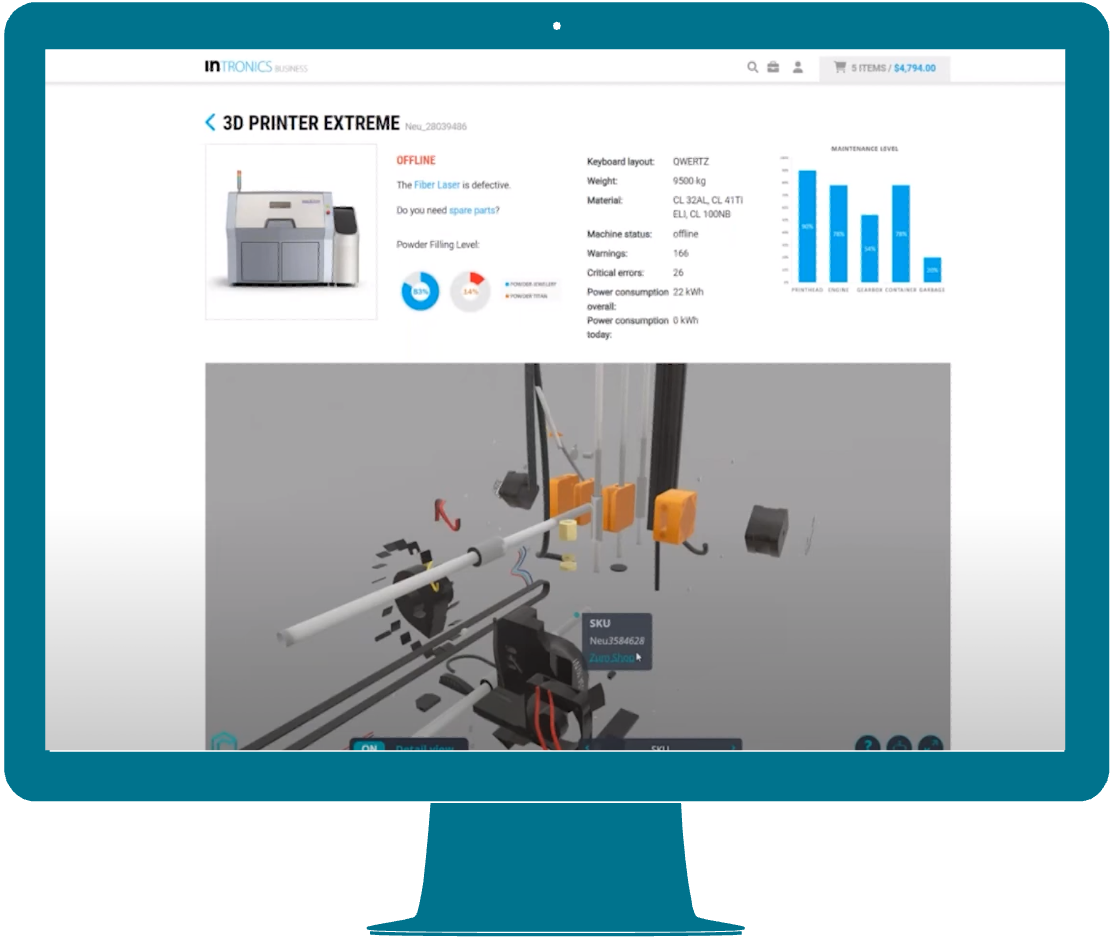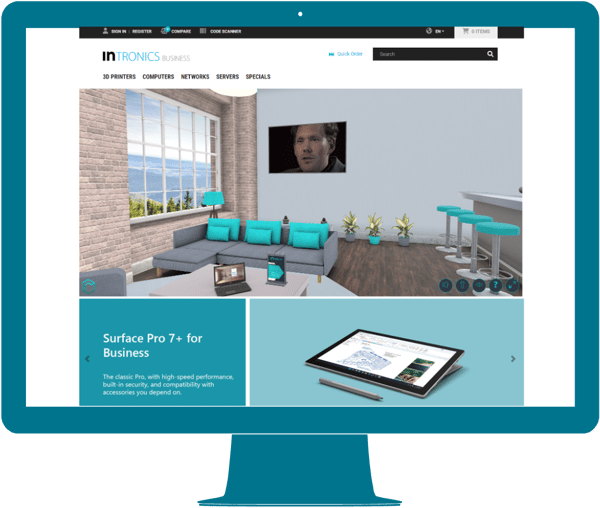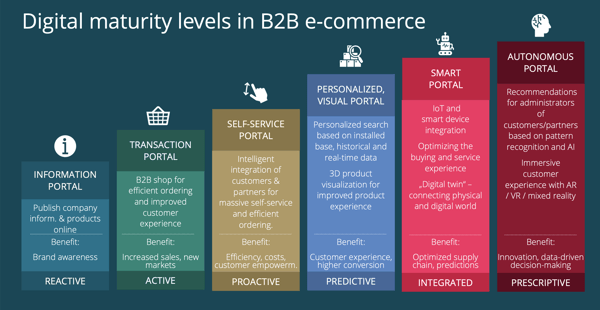None of us wants to buy the proverbial pig in a poke. Actually to see what you are buying, to be able to look at it from every angle is one of the greatest advantages of traditional trade. So, it is no wonder that virtual commerce technologies in e-commerce are gaining ground and are revolutionizing not only the B2C industry, but also the B2B industry.
This article investigates the potential of virtual commerce for B2B companies and provides you with answers to the following questions:
2. What advantages do virtual commerce technologies offer for B2B companies?
3. Use cases and best practices: What examples of application are there in the B2B context?

1. What is virtual commerce?
Virtual commerce is a form of e-commerce in which customers can experience products and services in a virtual environment. In contrast to traditional e-commerce where products can only be seen in photos or described in texts, virtual commerce allows for a more realistic presentation of products. The result is an improved shopping experience, which leads to a longer time spent on the website, stronger customer loyalty and optimized key performance indicators (KPIs).
Virtual commerce takes various shapes and may include, for instance, virtual reality (VR), augmented reality (AR) or 3D models:
-
In a virtual reality environment, customers can experience products and services in a virtual world and look around as if they were physically present.
-
In augmented reality scenarios, digital elements are integrated into the real environment in order to offer the customer an “expanded experience”.
-
3D models can help customers better understand complex products by looking at them from various perspectives and being able to take them apart to see their individual parts. Especially in the B2B context, 3D models and exploded graphs are of major significance, for instance, with procurement of spare and worn parts.
Virtual commerce is thus the development of traditional e-commerce. The same range of products is offered, but the shopping experience takes place in the metaverse — an immersive, all-encompassing 3D world where the range of products and the sales room are presented by e-commerce companies with architectonic elements, customer journeys and visual merchandising.

2. What advantages do virtual commerce technologies offer for B2B companies?
Virtual commerce is one of the megatrends in B2B e-commerce because it offers numerous advantages to the company. In brief, virtual commerce offers B2B companies the opportunity to present products and services in an innovative and interactive way. In this way, they can strengthen customer loyalty and brand image and increase their sales figures.
Let’s take a closer look at the advantages of virtual commerce:
1. Improved product presentation: By using 3D models, exploded graphs and other interactive elements, companies can present complex products in a way that is realistic and easy to understand and offer detailed product information. This helps customers have a better understanding of products and make buying decisions more quickly.
2. Higher interactivity: Virtual commerce offers customers an interactive experience where they can look at the products from various perspectives and see them in action. This helps the customers feel more closely connected to products and thus it is more likely that they will be willing to buy them.
3. Longer time spent on the website: 3D content makes customers spend three times as much time on commerce websites — a huge plus from SEO perspective! The time spent sends a positive signal to search machines and shows that the shop visitors show interest in the contents that are presented. The result is that they rank better and are found more quickly..
4. Higher conversion rates: Traditional online shops previously operated only in 2D. But countless best-practice applications have confirmed globally that one factor is critical when hunting through an online shop: how well pictures of products attract the attention of customers. Studies show that the probability that a product will be sold increases by an average of 50% if 3D models are used in the product presentation. With augmented reality applications, the probability of sales increases by even 65%.
5. Quicker identification of replacement parts: If a machine is defective, downtimes quickly lead to productivity losses and higher costs. Quickly procuring the right replacement part is thus of great importance for B2B companies. With the use of 3D models and exploded graphs, tediously leafing through product catalogues is no longer necessary because the desired replacement parts are quickly and correctly identified and can be immediately put into the product cart.
6. Fewer returns: With an improved product presentation featuring detailed production information, customers can make better purchase decisions and reduce the risk of buying the wrong thing and hence returns.
7. Higher customer satisfaction: Virtual commerce can contribute to increasing customer satisfaction by offering customers an innovative and pleasant shopping experience. Companies that use virtual commerce can stand out from the competition and build up a loyal customer base.
8. Orientation to the future: Virtual commerce is a future-oriented technology that will be continually developed and it offers companies the opportunity to adapt to customers’ changing needs.
Due to these benefits, virtual commerce has become a major trend in B2B e-commerce since 2023 and will become even more important in the future.

3. Use cases and best practices: What examples of virtual commerce application are there in the B2B context?
In view of the advantages described, it is no wonder that immersive commerce technologies, visual search and visual configuration tools show up in Gartner’s “Hype Cycle for Digital Commerce” - an analysts’ report that describes various phases that technologies and trends go through in the field of e-commerce – from discovery to adaptation. According to this report, a great potential for innovation is attributed to the issue of virtual commerce, connected with high expectations in the matter of customer experience.
The fact is that companies which integrate virtual commerce technologies into their online shop as an early adopter will get a significant jump on the competition and increase customer loyalty. This applies especially to companies from the B2B industry, in which digital trends are generally adopted somewhat later than in the B2C context.
Here are a few best practices for using virtual commerce technologies in the B2B scenario:
-
360° product displays: These displays offer customers the opportunity to turn high-resolution 3D pictures of products and look at them from every angle. This functionality is very interesting especially for very detailed or technical products with a lot of connections or various hardware configurations.
-
Exploded displays: Displays that show the product in a disassembled condition are another interesting example of application in the B2B context. In this way, B2B buyers can, for instance, check the components of a machine in order to ensure that they meet the requirements in terms of function and quality. This type of presentation is terrific when shopping for replacement parts as well.
 Figure: Exploded display of a 3D printer
Figure: Exploded display of a 3D printer
-
3D visualization in the real environment: This functionality offers the buyer the opportunity to see a 3D image of the product, for instance, a machine, in the physical environment in which it is intended to be used. With the camera of a cell phone or mobile device, the customer can record the physical environment in real time and insert into it a superimposed 3D display of the product. In this way, the buyer can “see virtually” how well a packaging machine can be integrated into their warehouse, for instance.
-
Click-and-move product markups: In principle, these act like an interactive user manual. With the help of clickable 3D displays, the use of complex mechanical products, for instance, heavy machines for assembly lines, can be visualized and valuable assistance can be given to correct common problems.
The technological opportunities from visualization technologies and their application scenarios in the B2B context are many. B2B companies are well advised to forge ahead bravely and, for instance, “try out” use of 3D models in online production presentation. A minimum-viable-product (MVP) approach is suitable for this as an experiment with high-margin, comparably high-priced products. If points are scored in customer satisfaction and conversion, additional virtual-commerce applications can be integrated into the e-commerce strategy little by little.

4. How can 3D models, virtual reality applications and augmented reality applications be integrated into your B2B e-commerce strategy in a profitable way?
To effectively integrate 3D models, virtual reality (VR), and augmented reality (AR) into your B2B e-commerce strategy, companies should consider their digital maturity level. Starting from an information portal, you can gradually incorporate these technologies as you evolve through various stages—transaction portals, self-service, and personalized visual experiences—ultimately leading to smart and autonomous portals. This progressive integration enhances customer experience, strengthens brand loyalty, and drives sales by offering immersive, tailored interactions at each stage of your e-commerce development.
Let’s take a closer look at the typical trajectory of development in B2B e-commerce:
1. Information portal: Many B2B companies who have their sights set on digitalizing their interaction with customers, including all sales and service processes, generally start up an online catalogue, i.e., they provide their customers with comprehensive information about their product and service portfolio in an information portal. Documentation, manuals, tutorials and contact addresses score points in the area of service. Even if there is no opportunity to place online orders yet, but at least only make reference to the nearest specialists, immersive worlds are already created at this stage by means of virtual technologies that sustainably strengthen both the brand image and customer loyalty.

Figure: Immersive experience on a B2B company website
2. Transaction portal: This is just the classic B2B online shop in which the customer not only finds comprehensive product and service information, but also has the opportunity to purchase the products on offer. Many B2B companies are in this stage of development and are willing to take the next steps on their digitalization journey by testing out, for instance, new innovative technologies, investigating scaling options or expanding their business internationally. Integrating 360° product displays into the B2B online shop is only an example of how B2B companies can increase conversion rates and improve the customer’s shopping experience.
3. Self-service portal: The trend towards digital self-services and their implementation in a digital customer portal continues to pick up speed in the B2B industry. By offering their customers tailor-made, individualized self-services, including 24/7 access to product and service information, e-learning proposals, as well as independent management of their own data, service contracts, workflows and cost center budgets, B2B companies optimize the customer journey and also see to it that there are increasing after-sales revenues after the actual purchase. Furthermore, with links to service partners, they expand their range of services and thus increase customer satisfaction.
4. Personalized, visual portal: Products, information and services are offered here in a highly personalized and visually supported way. If they are logged into the portal, B2B customers see personalized search results, individually agreed prices and—quite importantly in B2B—their installed basis, including additional products, appropriate replacement parts and consumable materials. A 3D visualization of products and an immersive experience offers a lot of space for an optimized customer experience and for increasing sales at this stage of development.
5. Smart portal: The premium class. By linking a digital customer portal to the internet of things (IoT) and smart, technology-support devices, B2B companies offer their customers intelligent services for the industry 4.0, including, for instance, exceptional response times or availability commitments, service support by means of virtual reality, tool monitoring, optimization of consumption or predictability about material wear and tear. Digital twins as virtual representations of real products or systems are linked to sensors, data and algorithms that make it possible, for instance, to monitor and optimize the operation, consumption and wear of a machine (which is a part of the installed basis) in the customer portal. The result is stronger customer loyalty, more efficiency, lower costs and minimized machine downtimes.
6. Autonomous portal: The intelligent future. This final stage of development, which is currently still more vision than reality, is about creating a self-managing B2B e-commerce experience that integrates buyers, retailers, suppliers, partners and the internet of things (IoT), thereby perfecting the customers’ journey and supporting every trade decision through technology. An immersive experience made up of augmented reality, virtual reality and mixed reality supports customers as well as manufacturers and wholesalers in every single phase of interaction and thus makes a critical contribution for strong customer loyalty, a high level of transfer of knowledge and an innovative future of B2B e-commerce.

Figure: Digital maturity levels in B2B e-commerce
3D product visualization: simple, universal and quick with a rooom, Smart Commerce and Intershop
On the whole, it can be observed that virtual commerce technologies are more than only hype. For B2B companies, they offer the opportunity to improve the customers’ shopping experience and to design their experience to be more interactive and emotional. Hence, it is expected that relevant application scenarios which increasingly develop or process VR and AR technologies will become more and more popular in the future. According to the report “Seeing is Believing” from PwC, VR and AR could contribute 1.5 billion USD to the global economy by 2030 and create almost 24 million new jobs.
So, the demand for virtual-experience solutions, as they are offered by, for instance, rooom AG, is currently increasing enormously. In the end, it’s no wonder that they make it easier for shop operators to enter virtual commerce in a profitable way. With the rooom 3D product viewer, for instance, 3D models of products are integrated easily and seamlessly into B2B online shops or websites and thus create a product experience that is close to reality. With one single click, customers can project the 3D products directly next to them—even in augmented reality (AR). It’s also of interest that the implementation expert Smart Commerce has recognized the potential for B2B e-commerce scenarios and has integrated the rooom 3D product viewer, an application from rooom productCloud, into the Intershop Commerce Platform. This is a huge opportunity for Intershop customers and those who want to become one!
Virtual commerce is set to remain one of the most influential trends shaping B2B e-commerce in the coming years. Stay ahead by exploring our latest insights in the Digital Trends Report, and gain valuable inspiration to refine and elevate your B2B e-commerce strategy.







